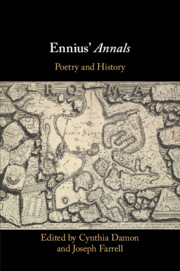Book contents
- Ennius’ Annals
- Ennius’ Annals
- Copyright page
- Dedication
- Contents
- Contributors
- Abbreviations
- Introduction: History and Poetry in Ennius’ Annals
- I Innovation
- II Authority
- III Influence
- Chapter 8 Ennius and the fata librorum
- Chapter 9 How Ennian Was Latin Epic between the Annals and Lucretius?
- Chapter 10 Livy’s Ennius
- Chapter 11 Ennius’ Annals and Tacitus’ Annals
- IV Interpretation
- Afterword
- Works Cited
- General Index
- Index Locorum
Chapter 8 - Ennius and the fata librorum
from III - Influence
Published online by Cambridge University Press: 10 April 2020
- Ennius’ Annals
- Ennius’ Annals
- Copyright page
- Dedication
- Contents
- Contributors
- Abbreviations
- Introduction: History and Poetry in Ennius’ Annals
- I Innovation
- II Authority
- III Influence
- Chapter 8 Ennius and the fata librorum
- Chapter 9 How Ennian Was Latin Epic between the Annals and Lucretius?
- Chapter 10 Livy’s Ennius
- Chapter 11 Ennius’ Annals and Tacitus’ Annals
- IV Interpretation
- Afterword
- Works Cited
- General Index
- Index Locorum
Summary
If readers determine the fate of books, we might think the Annals of Quintus Ennius enjoyed but ephemeral success. Its fragments are few, its original audience and intent unclear. In this paper I ask how so vast a monument became such a ruin, and what the evidence of its survival reveals about the process of its destruction. Those who knew the poem best are among that handful of Romans – Cicero and Vergil prominent among them – whom we know best. What did “ordinary” Romans know, pretend to know, or could they be expected to know of it? Close attention to the poem’s reception suggests that it was best known through favored extracts and that the idea of the Annals was more firmly fixed in the Roman literary consciousness than the poem itself.
- Type
- Chapter
- Information
- Ennius' AnnalsPoetry and History, pp. 169 - 187Publisher: Cambridge University PressPrint publication year: 2020

